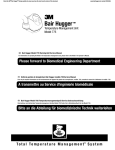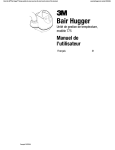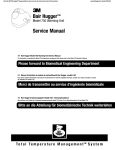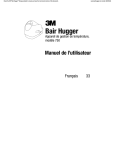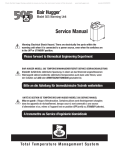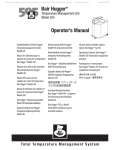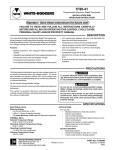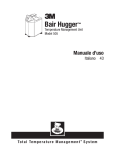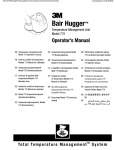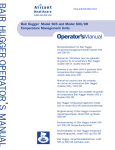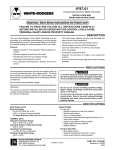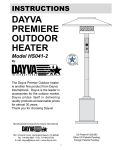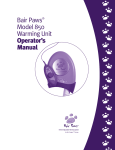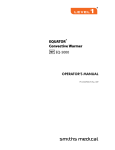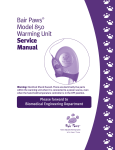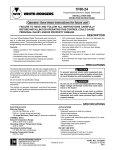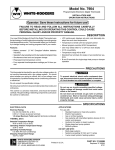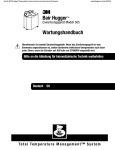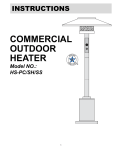Download Model 750 Service Manual, reorder #200595G
Transcript
Check the Bair Hugger therapy website to ensure you have the most recent version of this document. www.bairhugger.com reorder #200595G Bair Hugger* Model 750 Warming Unit Service Manual Warning: Electrical Shock Hazard. There are electrically live parts within the temperature management unit when it is connected to a power source, even when the unit is in Standby mode. For information on operating the Model 750 temperature management unit, please refer to the Model 750 Operator’s Manual. Please forward to Biomedical Engineering Department Bair Hugger Modell 750 Temperaturmanagementgerät Service Gebrauchsanleitung Warnung: Gefährliche elektrische Spannung. In einem an das Netz angeschlossenen Temperaturmanagement-Gerät stehen bestimmte elektrische Komponenten auch dann unter Strom, wenn sich das Gerät im Betriebsmodus Standby befindet. Informationen zum Betrieb des Temperaturmanagement-Gerätes Modell 750 finden Sie im Betriebshandbuch für das Modell 750. Bitte an die Abteilung für biomedizinische Technik weiterleiten Unité de gestion de température Bair Hugger modèle 750 Service Manuel Avertissement : risque de secousses électriques. L’appareil de gestion de la température contient des pièces qui sont sous tension lorsqu’il est raccordé à une source d’alimentation et cela même si l’appareil est en mode d’attente. Pour de plus amples informations sur le fonctionnement de l’appareil de gestion de la température, modèle 750, consulter le manuel de l’utilisateur du modèle 750. A transmettre au Service d’ingénierie biomédicale To t a l Te m p e r a t u r e M a n a g e m e n t * S y s t e m Bair Hugger* Model 750 Warming Unit Service Manual English 1 Deutsch 29 Français 59 Table of Contents Introduction � � � � � � � � � � � � � � � � � � � � � � � � � � � � � � � � � � � � � � � � � � � � � � � � � � � � � � � � � � � � � � � � � � � � � 1 Description of the Total Temperature Management System � � � � � � � � � � � � � � � � � � � � � � � � 1 Indications� � � � � � � � � � � � � � � � � � � � � � � � � � � � � � � � � � � � � � � � � � � � � � � � � � � � � � � � � � � � � � � � � � � � 1 Contraindications � � � � � � � � � � � � � � � � � � � � � � � � � � � � � � � � � � � � � � � � � � � � � � � � � � � � � � � � � � � � � 1 Warnings � � � � � � � � � � � � � � � � � � � � � � � � � � � � � � � � � � � � � � � � � � � � � � � � � � � � � � � � � � � � � � � � � � � � � 1 Cautions� � � � � � � � � � � � � � � � � � � � � � � � � � � � � � � � � � � � � � � � � � � � � � � � � � � � � � � � � � � � � � � � � � � � � � 2 Notices � � � � � � � � � � � � � � � � � � � � � � � � � � � � � � � � � � � � � � � � � � � � � � � � � � � � � � � � � � � � � � � � � � � � � � � 3 Proper Use and Maintenance � � � � � � � � � � � � � � � � � � � � � � � � � � � � � � � � � � � � � � � � � � � � � � � � � � � 3 Read Before Servicing Equipment � � � � � � � � � � � � � � � � � � � � � � � � � � � � � � � � � � � � � � � � � � � � � � � 3 Safety Inspection � � � � � � � � � � � � � � � � � � � � � � � � � � � � � � � � � � � � � � � � � � � � � � � � � � � � � � � � � � � � � � 3 Overview � � � � � � � � � � � � � � � � � � � � � � � � � � � � � � � � � � � � � � � � � � � � � � � � � � � � � � � � � � � � � � � � � � � � � � � � 4 Unit Power-On-Reset � � � � � � � � � � � � � � � � � � � � � � � � � � � � � � � � � � � � � � � � � � � � � � � � � � � � � � � � � � 4 Operating Modes � � � � � � � � � � � � � � � � � � � � � � � � � � � � � � � � � � � � � � � � � � � � � � � � � � � � � � � � � � � � � � 5 Standby Mode� � � � � � � � � � � � � � � � � � � � � � � � � � � � � � � � � � � � � � � � � � � � � � � � � � � � � � � � � � � � � � � � � 5 Fault Conditions� � � � � � � � � � � � � � � � � � � � � � � � � � � � � � � � � � � � � � � � � � � � � � � � � � � � � � � � � � � � � � � 6 Over-Temperature Condition � � � � � � � � � � � � � � � � � � � � � � � � � � � � � � � � � � � � � � � � � � � � � � � � � � � 6 Alternative Modes � � � � � � � � � � � � � � � � � � � � � � � � � � � � � � � � � � � � � � � � � � � � � � � � � � � � � � � � � � � � � 7 Accessing the Alternative Modes � � � � � � � � � � � � � � � � � � � � � � � � � � � � � � � � � � � � � � � � � � � � � � � � 8 Exiting an Alternative Mode� � � � � � � � � � � � � � � � � � � � � � � � � � � � � � � � � � � � � � � � � � � � � � � � � � � � 8 9 9 Service Procedures � � � � � � � � � � � � � � � � � � � � � � � � � � � � � � � � � � � � � � � � � � � � � � � � � � � � � � � � � � � � � � � Calibrating the Operating Temperatures � � � � � � � � � � � � � � � � � � � � � � � � � � � � � � � � � � � � � � � � � Testing the Over-Temperature Detection System� � � � � � � � � � � � � � � � � � � � � � � � � � � � � � � � � 11 Viewing the Fault Code Log � � � � � � � � � � � � � � � � � � � � � � � � � � � � � � � � � � � � � � � � � � � � � � � � � � � 13 Clearing the Fault Code Log � � � � � � � � � � � � � � � � � � � � � � � � � � � � � � � � � � � � � � � � � � � � � � � � � � � 13 Fault Code Table� � � � � � � � � � � � � � � � � � � � � � � � � � � � � � � � � � � � � � � � � � � � � � � � � � � � � � � � � � � � � � 14 Viewing the Hour Meter � � � � � � � � � � � � � � � � � � � � � � � � � � � � � � � � � � � � � � � � � � � � � � � � � � � � � � 15 Viewing the Operating Timer� � � � � � � � � � � � � � � � � � � � � � � � � � � � � � � � � � � � � � � � � � � � � � � � � � 15 Replacing the Air Filter� � � � � � � � � � � � � � � � � � � � � � � � � � � � � � � � � � � � � � � � � � � � � � � � � � � � � � � � 16 Replacing the Hose� � � � � � � � � � � � � � � � � � � � � � � � � � � � � � � � � � � � � � � � � � � � � � � � � � � � � � � � � � � � 17 Cleaning the Warming Unit � � � � � � � � � � � � � � � � � � � � � � � � � � � � � � � � � � � � � � � � � � � � � � � � � � � 19 Troubleshooting� � � � � � � � � � � � � � � � � � � � � � � � � � � � � � � � � � � � � � � � � � � � � � � � � � � � � � � � � � � � � � � � � Technical Support and Customer Service � � � � � � � � � � � � � � � � � � � � � � � � � � � � � � � � � � � � � � � � 20 22 When You Call for Technical Support� � � � � � � � � � � � � � � � � � � � � � � � � � � � � � � � � � � � � � � � � � � 22 In-Warranty Repair and Exchange� � � � � � � � � � � � � � � � � � � � � � � � � � � � � � � � � � � � � � � � � � � � � � 22 Returning Units for Service� � � � � � � � � � � � � � � � � � � � � � � � � � � � � � � � � � � � � � � � � � � � � � � � � � � � 23 Specifications� � � � � � � � � � � � � � � � � � � � � � � � � � � � � � � � � � � � � � � � � � � � � � � � � � � � � � � � � � � � � � � � � � � � 24 Maintenance Log � � � � � � � � � � � � � � � � � � � � � � � � � � � � � � � � � � � � � � � � � � � � � � � � � � � � � � � � � � � � � � � � 26 Definition of Symbols � � � � � � � � � � � � � � � � � � � � � � � � � � � � � � � � � � � � � � � � � � � � � � � � � � � � � � � � � � � 27 Bair Hugger Model 750 Temperature Management Unit Service Manual Introduction Description of the Total Temperature Management System The Bair Hugger brand Total Temperature Management* system consists of a Model 750 forcedair temperature management unit (with available rolling stand and sheet clip) and disposable components, including Bair Hugger forced-air blankets, Bair Paws* patient warming gowns, and the 241* blood/fluid warming set. You can use the Model 750 temperature management unit in all clinical settings including the operating room to provide patient temperature management. This manual includes operating instructions and unit specifications for the Model 750 temperature management unit. For information about using Bair Hugger blankets, Bair Paws gowns, or the 241 blood/fluid warming set with the Model 750 temperature management unit, refer to the “Instructions for Use” included with each of these disposable components. Indications The Bair Hugger Temperature Management system is intended to prevent and treat hypothermia. In addition, the temperature management system can be used to provide patient thermal comfort when conditions exist that may cause patients to become too warm or too cold. The temperature management system can be used with adult and pediatric patients. Contraindications Do not apply heat to lower extremities during aortic cross-clamping. Thermal injury may occur if heat is applied to ischemic limbs. Warnings 1. Do not leave patients with poor perfusion unmonitored during prolonged warming therapy sessions. Thermal injury may result. 2. The Bair Hugger temperature management unit has been designed to operate safely ONLY with Arizant Healthcare* disposable components. Use with other products may cause thermal injury. (To the full extent permitted by law, the manufacturer and/or importer declines all responsibility for thermal injury resulting from the unit being used in conjunction with non-Arizant Healthcare products.) 3. Do not warm patients with the temperature management unit hose alone. Thermal injury may result. Always connect the hose to a Bair Hugger blanket or Bair Paws gown before providing therapy. 4. Do not place the non-perforated side of the blanket on the patient. Thermal injury may result. Always place the perforated side (that is, with small holes) towards the patient. 5. Do not continue temperature management therapy if the over-temp indicator light illuminates and the alarm sounds. Thermal injury may result. Unplug the unit, and contact a qualified service technician. English 200595G 1 Bair Hugger Model 750 Temperature Management Unit Service Manual 2 6. Do not continue 241 blood/fluid warming therapy if the over-temp indicator light illuminates and the alarm sounds. Immediately stop fluid flow, and discard the blood/fluid warming set. Unplug the temperature management unit, and contact a qualified service technician. 7. Do not use a forced-air warming device over transdermal medication. Increased drug delivery and patient injury or death may occur. 8. Do not allow the patient to lie on the warming unit hose or allow the hose to directly contact the patient’s skin during patient warming; thermal injury may result. 9. Equipment not suitable for use in the presence of a flammable anesthetic mixture with air or with oxygen or nitrous oxide. 10. Resuable blankets made from woven fabric, or blankets without discrete, visible holes, can cause the safety system of this unit to fail, which may result in serious thermal injury. This warming unit has been designed to operate safety ONLY with Bair Hugger® blankets or Bair Paws gowns. Cautions 1. Except for specific blanket models, Bair Hugger blankets are not sterile and are all intended for single patient use ONLY. Placing a sheet between the Bair Hugger blanket and the patient does not prevent contamination of this product. 2. Monitor the temperature and cutaneous response of patients who are incapable of reacting, communication and/or who are without a sense of feeling every 10-20 minutes or according to institutional protocol. Monitor the patient's vital signs regularly. Adjust air temperature or discontinue therapy when the therapeutic goal is reached or if vital sign instability occurs. Notify physician of vital sign instability immediately. 3. Do not leave pediatric patients unattended during therapy. 4. Do not initiate temperature management therapy unless the temperature management unit is safely placed on a hard surface or securely mounted. Otherwise, injury may result. 5. To prevent tipping, clamp the Model 750 temperature management unit to an IV pole at a height that provides stability. We recommend clamping the unit no higher than 44 in. (112 cm) from the floor on an IV pole with a minimum 28 in. (71 cm) diameter wheelbase. Failure to do so may result in IV pole tipping, catheter site trauma, patient injury. 6. Electrical shock hazard. Do not disassemble the temperature management unit unless you are a qualified service technician. There are electrically live parts with in the unit when it is connected to a power source, even when the unit is in Standby mode. Arizant Healthcare Inc. Bair Hugger Model 750 Temperature Management Unit Service Manual Notices 1. The Bair Hugger temperature management unit meets medical electronic interference requirements. If radio frequency interference with other equipment should occur, connect the unit to a different power source. 2. Federal law (USA) restricts this device to sale by or on the order of a licensed healthcare professional. 3. To reliably ground this Bair Hugger warming unit, only connect to receptacles marked “Hospital Only” or “Hospital Grade”. Proper Use and Maintenance Arizant Healthcare Inc. assumes no responsibility for the reliability, performance, or safety of the temperature management unit if the following events occur: • Modifications or repairs are performed by unqualified personnel. • The unit is used in a manner other than that described in the Operator’s or Service Manuals. • The unit is installed in an environment that does not meet the appropriate electrical and grounding requirements. Read Before Servicing Equipment All repair, calibration, and servicing of the temperature management unit require the skill of a qualified, medical equipment service technician who is familiar with good practice for medical device repair. If service does not require the manufacturer’s attention, the Model 750 Service Manual provides the technical information needed to service the unit, or Arizant Healthcare Inc. will provide that information on request. Perform all repairs and maintenance in accordance with the instructions in the Service Manual. Safety Inspection Perform a safety inspection after making repairs to the Bair Hugger temperature management unit and before returning the unit to service. A safety inspection should include calibrating the operating temperature settings and testing the over-temperature detection function as described in this service manual as well as testing for leakage current and continuity check on safety ground. English 200595G 3 Bair Hugger Model 750 Temperature Management Unit Service Manual 4 Overview When you connect the Model 750 temperature management unit to a grounded power source, the unit automatically performs the power-on-reset operation described below. Following the power-on-reset operation, the unit will enter the Standby mode. You can select any operating mode by pressing the appropriate button on the unit’s control panel. See Figure 1. Alternative Mode button Figure 1. Control panel Unit Power-On-Reset The Model 750 temperature management unit performs the following power-on-reset sequence after you connect the unit to a grounded power source: • Performs all self-test functions. • Illuminates all indicator lights and all pixels in the alphanumeric display momentarily. • Displays the text “BH 750” and the software revision level in the alphanumeric display. • Produces 3 chirping sounds. • Enters the Standby mode. If the temperature management unit loses power for less than 1 second, the unit’s software will remain in the operating mode you selected prior to the power loss. If the unit loses power for longer than 1 second, the unit’s software will reset when you restore power. The unit will then enter the Standby mode. Arizant Healthcare Inc. Bair Hugger Model 750 Temperature Management Unit Service Manual Operating Modes The Model 750 temperature management unit has 4 operating modes: Ambient, Low, Medium, High. To select the Low, Medium, High, or Ambient mode, press the corresponding button. The temperature management unit will operate within the specified temperature range, shown in the table below. Temperature Mode Temperature of Delivered Air Low 32°C ± 1.5°C Medium 38°C ± 1.5°C High 43°C ± 1.5°C Ambient Unit will supply air that is slightly warmer than room-temperature After you select a temperature mode, the following events occur: • Corresponding indicator light illuminates. • Blower operates. • Heater activates except in Ambient mode. • Temperature mode timer and hour meter activate. • Temperature at the blanket-end of the hose appears in the alphanumeric display. • T emp in Range indicator light illuminates when the temperature at the blanket end of the hose is within ±1.5°C* of the selected setting; this indicator light does not illuminate in the Ambient mode. Standby Mode To place the unit in Standby mode, press the Standby button. When in Standby mode, the following events occur: • Standby indicator light illuminates. • Blower and heater turn off. • Alphanumeric display deactivates. • Temperature mode timer pauses. • Alarm and fault detection functions remain active. * Within ±3°C in units with < Rev L Software. The Rev version appears in the display window upon connection to a power source. English 200595G 5 Bair Hugger Model 750 Temperature Management Unit Service Manual 6 Fault Conditions The Model 750 temperature management unit’s software recognizes several nonhazardous fault conditions including: • Sensor failures • Heater failures • Computer failure • Software failure • Keypad failure • Power supply failure • Blower motor failure • Forced over-temperature test failure When a fault condition exists, the following events occur: • Fault indicator light flashes. • Audible alarm sounds. • Fault code appears in the alphanumeric display. • Up to 5* fault codes are stored in memory. When the audible alarm sounds, press any button on the keypad to temporarily silence it. The temperature management unit must be unplugged before it can be restarted. See Viewing the Fault Code Log and the Fault Code Table for more information about specific fault codes. Over-Temperature Condition When an overtemperature condition exists, the following events occur: • Over-temp indicator light flashes. • Audible alarm sounds. • Blower and heater turn off. • Fault code appears in the alphanumeric display (see Fault Code Table). When the audible alarm sounds, press any button on the keypad to temporarily silence it. The temperature management unit must be unplugged before it can be restarted. * Up to 3 fault codes in units with < Rev L software. The Rev version appears in the display window upon connection to a power source. Arizant Healthcare Inc. Bair Hugger Model 750 Temperature Management Unit Service Manual Alternative Modes The Model 750 temperature management unit has 5 alternative modes that allow access to the service and calibration utilities of the unit. Alternative Modes AltMode0 Hour meter AltMode1 Calibration AltMode2 Fault code log AltMode3 System information AltMode4 Over-temperature detection test The Hour Meter mode displays the cumulative amount of operating time (in Ambient, Low, Medium, and High modes) the temperature management unit has accrued since the initialization of EEPROM. The time is displayed in whole hours only. The Calibration mode allows a technician to check and adjust the nozzle temperature. This should be done as part of routine maintenance and always after servicing the temperature management unit or replacing the hose. The nozzle temperature can be altered a maximum of ±3.0°C by adjusting the calibration offset value. In the Calibration mode, the temperature management unit operates in the Ambient temperature mode, and the alphanumeric display shows the current nozzle temperature and calibration offset with 0.1°C precision. The Fault Code Log mode sequentially displays the last 5* fault codes stored in system memory. Please refer to the Fault Code Table for more information about a particular fault code. The System Information mode allows the technician to view important system information including the firmware, system identification, serial port baud rate, 5V power supply status, and the control board serial number. The Over-temperature Detection Test mode allows the user to test the operation of the independent over-temperature shutdown system. * The last 3 fault codes in units with < Rev L software. The Rev version appears in the display window upon connection to a power source. English 200595G 7 Bair Hugger Model 750 Temperature Management Unit Service Manual 8 Accessing the Alternative Modes To access the alternative modes, you must press the Alternative Mode button that is located on the front panel of the temperature management unit but is unlabeled. Press the “Bair Hugger” text on the bear logo when the instructions direct you to press the alternative mode button. Alternative Mode button Figure 2. Control panel To enter one of the alternative modes, press the alternative mode button in combination with one of the operating mode buttons, also located on the front panel. The chart on the following page indicates which keys must be pressed to enter each of the 5 alternative modes. When the correct combination of keys is pressed, the display reads “Hold for AltModeX,” where “X” represents the selected alternative mode from the list above. Exiting an Alternative Mode Exit the alternative modes by pressing the alternative mode button or by waiting for 60 seconds. You will need to access the alternative modes for several of the service procedures described in this manual. Arizant Healthcare Inc. Bair Hugger Model 750 Temperature Management Unit Service Manual Service Procedures caution Do not use automatic testers for service procedures; always test the temperature management unit manually. Failure to do so may cause Fault Code 053. Calibrating the Operating Temperatures caution Perform all temperature testing of the temperature management unit with an Arizant Healthcare Model 22110 Temperature Test Unit. Arizant Healthcare Inc. assumes no responsibility for the reliability, safety, or performance of the Total Temperature Management system if temperature tests or adjustments are made in any manner other than those described here. Improper measurement or adjustment of the temperature management unit’s normal operating temperature could result in patient exposure to temperatures outside of the indicated range and may lead to patient injury. Service frequency Every 6 months or 500 hours of use, or whenever service is performed. Tools/equipment Model 22110 Temperature Test Unit NOTES: • Th e Model 22110 Temperature Test Unit simulates the operating characteristics of Bair Hugger blankets when used with Bair Hugger temperature management units. • W hen using the Model 22110 Test Unit, take temperature readings using a calibrated thermometer that can accept a male, subminiature connector and read a “K” style thermocouple (e.g., a Fluke Model 52 K/J Thermometer). If the test unit’s connector does not fit your thermometer, remove the connector from the test unit and attach a connector that fits your meter. Be certain to observe polarity. English 200595G 9 Bair Hugger Model 750 Temperature Management Unit Service Manual 10 Method Note: If the temperature management unit has been stored at a temperature lower than 20°C, allow it to reach ambient temperature before beginning the calibration procedure. 4. Attach the Model 22110 temperature test device to the end of the temperature management unit hose. 5. Connect the temperature management unit to a grounded power source. The unit performs a self-test and automatically proceeds to Standby mode. 6. Press the Ambient button to place the unit in Ambient mode. Allow the unit to run in Ambient mode for at least ten minutes to equalize the temperature of the unit’s internal components. 7. Press the Alternative Mode button (see Figure 2) and the Ambient button simultaneously for 3 seconds. The temperature management unit is now in Calibration mode. In this mode, the temperature management unit performs the following tasks: • Low and Med indicator lights flash. • Blower activates. • Heater elements deactivate. • The text “TMP” and the temperature in °C (0.1°C resolution) at the end of the hose appear in the alphanumeric display. • The text “OS” and the current calibration offset value (0.1°C resolution) appear in the alphanumeric display. 8. Compare the temperature shown on the alphanumeric display and the temperature on the independent, temperature calibration device. • If the temperatures match, press the Alternative Mode button to return the temperature management unit to Standby mode. • If the temperatures do not match, adjust the temperature management unit’s displayed temperature: a. Press the Low button to decrease the temperature or the Med button to increase the temperature by 0.1°C. You can adjust the temperature of the temperature management unit a maximum of ±3°C. b. Continue to press the Low or Med button(s) until the temperature in the alphanumeric display matches the temperature on the calibration device. c. Press the Alternative Mode button to store the calibration offset value and return the temperature management unit to Standby mode. Note: If it is necessary to enter an offset value greater than ±3°C, there may be a defect in the set point sensor. Remove unit from service until a new hose assembly can be substituted. Arizant Healthcare Inc. Bair Hugger Model 750 Temperature Management Unit Service Manual Testing the Over-Temperature Detection System warning Do not perform the over-temperature detection system test while the temperature management unit is being used for temperature management therapy. Thermal injury may result. caution Connect each warming unit being tested to a separate power source. Service frequency Every 6 months or 500 hours of use, or whenever service is performed. Tools/equipment Model 22110 Temperature Test Unit Method note: If the temperature management unit has been stored at a temperature lower than 20°C, allow it to reach ambient temperature before beginning the test. 1. Connect the temperature management unit to a grounded power source. The unit performs a self-test and automatically proceeds to Standby mode 2. Connect the temperature test kit to the hose of the temperature management unit. 3. Press the Ambient button and allow the temperature management unit to run for 5 minutes. 4. Press the Alternative Mode button (See Figure 2) and the High button simultaneously for 3 seconds. The temperature management unit is now in a Forced Over-temperature mode. In this mode, the temperature management unit performs the following tasks: • Blower activates. • Heater elements continuously operate at full power. • High indicator light flashes. • Over-temperature timer activates. • “OT Test” flashes in the alphanumeric display. English 200595G 11 Bair Hugger Model 750 Temperature Management Unit Service Manual 12 5. Wait for the temperature management unit to perform the over-temperature test. When the test is complete, the temperature management unit performs the following tasks: • Heater elements deactivate. • Blower continues to operate. (note: The blower turns off if an over-temperature condition occurs during normal use.) 6. View the alphanumeric display to determine test outcome: a. PASS–The unit detected an over-temperature condition within 150* seconds. An alarm sounds for 2 short beeps. The text “PASS” flashes in the alphanumeric display, followed by these messages: 1. OT Test OT Test PASS-Prx OR PASS-Dst 2. TestTime XX Secs 3. Unplug To Reset b. FAIL–Unit did not detect an over-temperature condition within 150* seconds (time-out failure). An alarm sounds and the Fault indicator light flashes. The text “FAIL” flashes in the alphanumeric display, followed by these messages: 1. OT Test FAIL 2. TestTime 150* Secs 3. Unplug To Reset NOTE: Do not place a temperature management unit back into service if it fails the Overtemperature Detection System test. Send the unit back to Arizant Healthcare for repair. See Returning Units for Service. 7. Record the maximum temperature displayed by the test kit. (Use maintenance log on page 26.) If the temperature is >56°C (53°C ± 3°C typical) contact Arizant Healthcare technical service for further instructions. 8. Unplug the temperature management unit to reset it. *Within 90 seconds in units with < Rev L software. The Rev version appears in the display window upon connection to a power source. Arizant Healthcare Inc. Bair Hugger Model 750 Temperature Management Unit Service Manual Viewing the Fault Code Log Service frequency As often as necessary. Tools/equipment None required. Method 1. If your temperature management unit is already ON, you can access the fault code log from any operating mode. Otherwise, connect the temperature management unit to a grounded power source. The unit performs a self-test and automatically proceeds to Standby mode. Then select any operating mode. 2. Press the Alternative Mode button (see Figure 2) and the Low button simultaneously for 3 seconds. The temperature management unit is now in Fault Code Log mode. In this mode, the temperature management unit performs the following tasks: a. Continues to operate in current operating mode. b. Low and Med indicator light flashes. c. Text “FC(n) XX” appears in the alphanumeric display. “FC” is an abbreviation for the phrase “fault code,” “n” represents the numerical order of the fault code in the log, and “XX” represents the code for the fault condition. See Fault Code Table for a list of fault codes and their meanings. d. The time of each fault appears below “FC(n) XX” in the alphanumeric display. 3. Press either the Low or Med button to view the next fault code in the log. The temperature management unit stores a maximum of 5* fault codes in non volatile memory. 4. Press the Alternative Mode button to return the temperature management unit to its previous operating mode. Clearing the Fault Code Log note: This option is available only with software Rev M or greater. Put the unit in Fault Code Mode by pressing the Alternative Mode button and the Low button simultaneously for 3 seconds; then, press the High button. *Stores a maximum of 3 fault codes in units with < Rev L software. The Rev version appears in the display window upon connection to a power source. English 200595G 13 Bair Hugger Model 750 Temperature Management Unit Service Manual 14 Fault Code Table The software will detect and report the following conditions by displaying the corresponding fault code: Fault Condition_______________________________Fault Code Internal sensor 1 over-temperature condition 01 Hose end sensor 2 over-temperature condition 02 Hose end sensor 3 over-temperature condition 03 Internal sensor 1 shorted 04 Hose end sensor 2 shorted 05 Hose end sensor 3 shorted 06 Hose end sensor 2 open 07 Low wattage heater failure 08 Medium wattage heater failure 09 High wattage heater failure 10 A/D converter timeout 11 A/D startup check failed 12 (Reserved Fault Code) 13 Error in execution loop 14 Timeout on alphanumeric display busy flag clearing 15 RAM corruption in duplicate RAM locations 16 Error in executing a depressed key 17 Stuck key during startup 50 EEPROM is at max # write cycles 51 Non-0 EEPROM byte detected after zeroing 52 EEPROM checksum failure on copy # 1 53 EEPROM compare failure copy #1 to copy #2 54 EEPROM compare failure copy #1 to RAM 55 EEPROM write cycle time out 56 SPI byte transfer time out 57 EEPROM write error when entering standby 59 Real time clock failure 60 5 V power supply in excess of 5.333 V 100 5 V power supply under 4.667 V 101 Startup test EEPROM error 102 Startup test RAM error 103 Arizant Healthcare Inc. Bair Hugger Model 750 Temperature Management Unit Service Manual Viewing the Hour Meter Service frequency As often as necessary. Tools/equipment None required. Method 1. If your unit is already ON, you can begin the test from any operating mode. Otherwise, connect the temperature management unit to a grounded power source. The unit performs a self-test and automatically proceeds to Standby mode. Then select any operating mode. 2. Press the Alternative Mode button for 3 seconds. (See Figure 2.) The temperature management unit is now in Hour Meter Display mode. In this mode, the temperature management unit performs the following tasks: a. Continues to operate in current operating mode. b. “Hours” appears in the alphanumeric display. c. Cumulative hours of temperature management unit operation appear in the alphanumeric display. 3. Wait 60 seconds or press the Alternative Mode button to return the temperature management unit to its previous operating mode. Viewing the Operating Timer To view the amount of time the temperature management unit has been operating in the current temperature mode, press and hold the current temperature mode button for at least 3 seconds. The time is displayed in HH:MM:SS format. English 200595G 15 Bair Hugger Model 750 Temperature Management Unit Service Manual 16 Replacing the Air Filter Service frequency Every 12 months or 500 hours of use. Tools/equipment • Replacement air filter • #2 Phillips screwdriver warning Do not attempt to clean the air filter as it may contain hazardous microorganisms. Discard the filter in a manner consistent with institutional protocol for biohazardous material. Method 1. Disconnect the temperature management unit from the grounded power source. 2. Turn the temperature management unit upside down. 3. Remove the 2 screws located in the louvered filter cover. 4. Lift the filter cover off the temperature management unit. 5. Remove the air filter and discard it. 6. Place the new filter in the filter compartment with the gasket toward the filter ledge. 7. Replace the filter cover with the louvers facing the back of the temperature management unit. 8. Replace the 2 screws in the filter cover. Arizant Healthcare Inc. Bair Hugger Model 750 Temperature Management Unit Service Manual Replacing the Hose Service frequency As needed. Tools/equipment • Replacement hose • Phillips screwdriver • Slotted screwdriver (for grommet replacement option) • Needle-nose pliers • Screw grommets (included in kit) Method DETACHING HOSE 1. Disconnect the temperature management unit from the power source before replacing hose. 2. Unscrew the hose collar. 3. If present, use the Phillips screwdriver to remove the 2 screws that attach the hose to the unit. 4. Slide the hose out of the temperature management unit. The hose will still be attached to the unit by a cable. 5. Using the needle-nose pliers, carefully detach the cable connector from the header plug located inside the hose connector. See Figure 3. English 200595G 17 Bair Hugger Model 750 Temperature Management Unit Service Manual 18 Figure 3. Hose replacement REATTACHING HOSE 1. Attach the cable connector of the new hose to the header plug, making sure that the protrusions on the connector align with the corresponding slots on the header. 2. Align the flat section of the hose end with the corresponding flat part of the unit’s hose connector and slide the replacement hose into the temperature management unit. 3. Screw the hose collar back into place. 4. Reconnect the temperature management unit to a grounded power source. 5. Calibrate operating temperature settings. 6. Perform over-temperature detection system test. Arizant Healthcare Inc. Bair Hugger Model 750 Temperature Management Unit Service Manual Cleaning the Warming Unit Service frequency As needed. Tools/equipment • Soft cloth lightly dampened with water • Mild detergent or antimicrobial spray • Dry soft cloth warning • Do not immerse the cabinet or hose while cleaning. Moisture will damage the components, and thermal injury may result. precautions • Do not use a dripping wet cloth to clean the cabinet. Moisture may seep into the electrical contacts and damage the components. • Do not use alcohol or other solvents to clean the cabinet. Solvents may damage the labels and other plastic parts. Method 1. Disconnect the temperature management unit from the power source before cleaning. 2. Wipe the cabinet and the outside of the hose with a damp, soft cloth and a mild detergent or antimicrobial spray. 3. Dry with a separate soft cloth. English 200595G 19 Bair Hugger Model 750 Temperature Management Unit Service Manual 20 Troubleshooting Permanent errors – a fault condition always occurs at turn on or after pressing a temperature setting Call Technical Support for Replacement Parts at 1-800-733-7775. Fault Code Possible Cause FC-01 Faulty hose end sensor at patient end. Replace hose. Refer to service manual or IFU included with replacement part for instructions. Faulty elbow sensor. Replace elbow sensor. Refer to IFU included with replacement part for instructions. Hose disconnected from unit. Reattach hose. Faulty heater element or faulty control board. Check continuity of J4 connector on control board. FC-02 FC-03 FC-04 FC-05 FC-06 FC-07 FC-08 FC-09 Solution *Calibrate and return to service White to black FC-10 White to blue White to yellow If “open”, replace heater. Otherwise, replace control board. *Calibrate and return to service FC-50 Defective user interface. Replace user interface. *Calibrate and return to service FC-53, 54 EEPROM error. Reset microprocessor. (Press the Bair Hugger logo and Standby button at same time while connected to power source. Release buttons when Standby light remains on). *Calibrate and return to service FC-100 FC-101 Defective control board. Replace control board. *Calibrate and return to service Arizant Healthcare Inc. Bair Hugger Model 750 Temperature Management Unit Service Manual Cautionary Errors – Fault condition while unit is use Fault Code Solution FC-01 Hose end at patient end occluded. Disconnect from power source. Remove hose occlusion. Position hose end correctly into hose card (refer to the operator’s manual). Reconnect to power source. If no fault occurs, unit is ready for use. FC-02 Hose end sensor failure at patient end. Faulty elbow sensor. Disconnect from power source. Allow unit to cool. Reconnect to power source. If no fault occurs, unit is ready to use. FC-03 FC-04 FC-05 FC-06 FC-07 English 200595G Possible Cause 21 Moisture. Intermittent sensor failure. High heat. Bair Hugger Model 750 Temperature Management Unit Service Manual 22 Technical Support and Customer Service USA, Worldwide TEL: 800-733-7775 952-947-1200 FAX: 800-775-0002 952-947-1400 Within Europe TEL: FAX: +49-4154-9934-0 +49-4154-9934-20 0800-100-1324 (Toll-free in Germany)0800-100-1324 (Toll-free in Germany) 0800-877-077 (Toll-free in Switzerland)0800-877-088 (Toll-free in Switzerland) When You Call for Technical Support We will need to know the serial number of your Bair Hugger temperature management unit when you call us. The serial number label is located on the back or side of the unit. In-Warranty Repair and Exchange USA Call Arizant Healthcare customer service if your Model 750 temperature management unit requires factory service. A customer service representative will give you a Return Authorization (RA) number. Please use this RA number on all correspondence concerning your temperature management unit. Your customer service representative will also send a shipping carton to you at no charge, if needed. Call your local supplier or sales representative to inquire about borrowing a temperature management unit while we service your unit. Worldwide Contact your local distributor concerning in-warranty repair and exchange. Arizant Healthcare Inc. Bair Hugger Model 750 Temperature Management Unit Service Manual Returning Units for Service Tools/equipment • Arizant Healthcare service carton • Tape dispenser • Shipping label • Marking pen Method 1. Call Technical Support to get a Return Authorization (RA) number and a service carton. 2. Remove the top foam piece. If the plastic liner is available, use it to enclose the the temperature management unit. 3. Lower the temperature management unit carefully into the carton. 4. Place the unit hose on the temperature management unit. See Figure 4. 5. Replace the top foam piece. Observe proper orientation. 6. Seal the carton with tape. 7. Apply the shipping label addressed to Arizant Healthcare Inc. 8. Write the RA number on the outside of the carton. 9. Ship to Arizant Healthcare. Figure 4. Packing configuration (View: Looking down into box.) English 200595G 23 Bair Hugger Model 750 Temperature Management Unit Service Manual 24 Specifications Physical Characteristics dimensions weight 12" high x 13.5" deep x 10" wide 30 cm high x 34 cm deep x 25 cm wide 15.5 lb (7kg) relative noise level 55 dBA hose lexible, compatible with the Bair Hugger brand 241 F blood/fluid warming system. filtration system High efficiency 0.2 µm filter recommended filter change Every 12 months or 500 hours of use. mounting an be clamped to an IV pole, placed on a hard C surface, or mounted to the rolling stand accessory. Temperature Characteristics recommended operating environment 15°C-25°C temperature control Electronically controlled. heat generated 1644 BTU/hr (average), 482 W (average) operating temperatures Average temperatures at the end of the hose: HIGH: 43° ± 1.5°C 109.4° ± 2.7°F MED: 38° ± 1.5°C 100.4° ± 2.7°F LOW: 32° ± 1.5°C 89.6° ± 2.7°F Safety System thermostat I ndependent electronic circuit; thermal cutoff shuts the heater OFF to ensure hose end air remains below 56°C (53°C ± 3°C typical): back-up over-temperature detection at hose inlet. alarm system ver-temperature (≤56°C, 53°C ±3°C typical): red O Over-temp indicator light flashes, alarm sounds, heater and blower shut down, operating indicator lights turn OFF, control panel becomes unresponsive. ault: amber Fault indicator light flashes, alarm F sounds, up to 5* fault codes stored in nonvolatile RAM. overcurrent protection Dual input fused lines. * 3 fault codes in units with < Rev L software. Arizant Healthcare Inc. Bair Hugger Model 750 Temperature Management Unit Service Manual Electrical Characteristics heating element 1400 W Resistive leakage current Meets UL 60601-1 and IEC 60601-1 requirements. blower motor perating speed: approximately 4,000 rpm O Airflow: up to 48 cfm or 23 L/s power consumption Peak: 1550 W Average: 800 W power cord 15 ft., SJT, 3 cond., 13 A 15 ft., SJT, 3 cond., 15 A 4.6 m, HAR, 3 cond., 10 A device ratings 110-120 VAC, 50/60 Hz, 11.7 A, or 220-240 VAC, 50/60 Hz, 7.2 A, or 100 VAC, 50/60 Hz, 15 A fuses 12 A (110 - 120 VAC) 8 A (220 - 240 VAC) 15 A (100 VAC) certifications I EC 60601-1: UL 60601-1; CAN/CSA-C22.2, No. 601.1; EN 60601-1-2; EN 55011; ASTM F2196-02. classifications lassified under EN 60601-1 Guidelines (and C other national versions of the Guidelines) as Class II, Type BF, Ordinary equipment, Continuous operation. Not suitable for use in the presence of flammable anesthetic mixtures with air or with oxygen or nitrous oxide. Classified by Underwriters Laboratories Inc. with respect to electric shock, fire, and mechanical hazards only, in accordance with UL 60601-1, ASTM F2196-02, and Canadian/ CSA C22.2, No. 601.1. Classified under the Medical Device Directive as a Class IIb device. diagnostics qualified service technician can perform overA temperature detection system testing, temperature output testing, operating temperature calibration (using the temperature test unit, part #22110), and fault code troubleshooting. English 200595G 25 Bair Hugger Model 750 Temperature Management Unit Service Manual 26 Maintenance Log Date Maintenance Action Performed Hour Meter Arizant Healthcare Inc. Bair Hugger Model 750 Temperature Management Unit Service Manual Definition of Symbols The following symbols may appear on the product’s labeling or exterior packaging. ON/STANDBY ON (used on isolation switch) OFF (used on isolation switch) ON/OFF push button switch Temperature control Equipotentiality plug (ground) Fuse ! Caution Attention, consult appropriate documents Warning Dangerous voltage Type BF equipment (patient applied) VAC V Voltage, alternating current (AC) Special Refuse, discard separately Protective earth ground No free hosing English 200595G 27 ©2009 Arizant Healthcare Inc. All rights reserved. 10393 West 70th Street, Eden Prairie, MN 55344 USA TEL 800-733-7775 • 952-947-1200 | FAX 800-775-0002 • 952-947-1400 | www.bairhugger.com Authorized Representative in the European Community: Arizant UK Limited, Calder Island Way, Wakefield, WF2 7AW TEL (44) 1924 200550 | FAX (44) 1924 200518 *Bair Hugger, Bair Paws, Arizant Healthcare, Arizant, bright ideas that work, 241, Total Temperature Management, and the Bair Hugger and Arizant logos are trademarks of Arizant Healthcare Inc., registered or pending in the U.S. Patent & Trademark Office and in other countries. May be covered by one or more of the following patent numbers: U.S. 7,101,389; 6,511,501; 6,355,915; 6,309,409; 6,309,408; 6,290,716; 6,287,327; 6,254,337; 6,241,755; 6,228,107; 6,210,428; 6,203,567; 6,176,870; 6,168,612; 6,146,412; 6,126,681; 6,126,393; 6,129,936; 6,036,722; 5,997,572; 5,968,084; 5,964,792; 5,928,274; 5,824,025; 5,800,489; 5,773,275; 5,733,318; 5,697,963; 5,674,269; 5,658,325; 5,620,482; 5,545,194; RE38462; 5,350,417; 5,336,250; 5,324,320; 5,300,102; 5,300,101; 5,184,612; 5,044,364. Japan 2,561,326. Canada 1,325,484. Australia 756,900; EPO 0,311,336. UK 2,358,746B. Other patents pending. 200595G 07/09

































